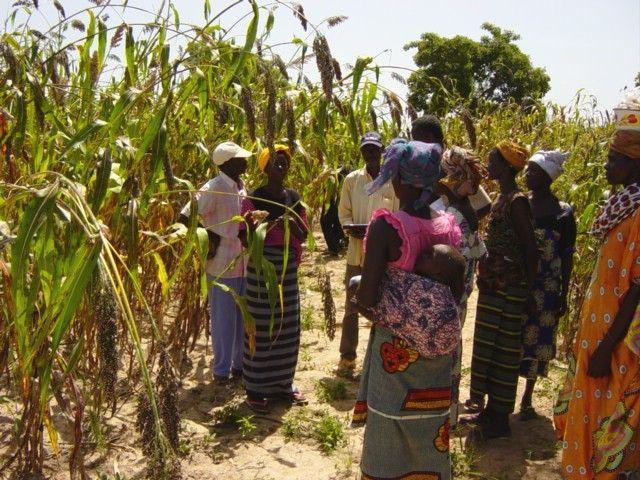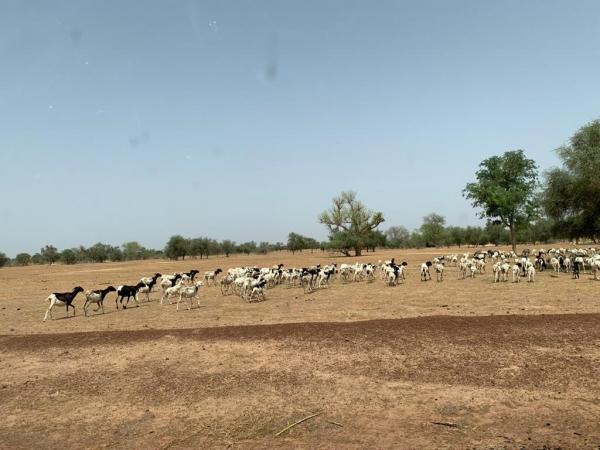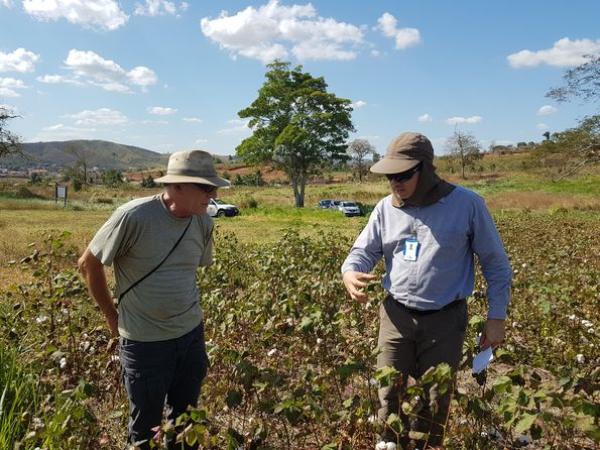This was a turning point in terms of breeding practices. Coupled with the production of certified seeds, participatory breeding is a particularly effective way of creating and disseminating varieties that satisfy farmers' needs. It has enabled massive take-up of improved varieties, large-scale seed production, and greater professionalization of producers as a whole.
Sorghum is the main cereal grown in Burkina Faso, with more than 1 500 000 hectares. Along with millet, it is the staple food for rural communities in the region, but yields have always been low, at just a tonne or so per hectare, despite a succession of varietal breeding programmes.
In the 1990s, researchers realized that conventional varietal breeding was not capable of producing improved sorghum varieties that satisfied producers' needs. This prompted the idea of involving those producers in creating new varieties: participatory breeding. Over 20 years, from 1995 to 2015, a range of projects implemented the new breeding method and worked to produce and market the resulting improved seed. They centred on two parts of the country: Centre-Nord and the Boucle du Mouhoun, with their contrasting agroecological conditions.
Centre-Nord is in the Sahelian climate zone, with less than 600 mm of rainfall per year. Its production systems focus on millet, sorghum and cowpea growing and small ruminant rearing. The Boucle du Mouhoun is in the North of the Sudanian zone, with between 600 and 900 mm of rainfall. Its production systems are more diversified, including commercial crops such as cotton, maize and sesame.
Working with farmers to design new varieties
Sorghum participatory breeding in Burkina Faso began in 1995, when researchers from CIRAD and INERA, the Burkinabe agricultural research organization, set up on-farm varietal trials.
Operations were still top-down, with researchers making the decisions and not asking producers for their opinion until they had created new varieties. Nevertheless, this scheme can be seen as the forerunner to participatory breeding.
This initial phase ran until the start of the 2000s, and was followed in 2002 by the first large-scale project on sorghum agro-biodiversity, coordinated by CIRAD.
A turning point in terms of sorghum breeding
That project marked a turning point for sorghum breeding, with the advent of truly participatory breeding operations and support for seed production. The aim was to work with and for farmers to produce new sorghum varieties by exploiting the genetic diversity that existed among traditional varieties. from the start, the project was backed by local farmers' organizations such as UGCPA and AMSP, which were involved in all the decisions made. It resulted in the dissemination of the first improved varieties developed using this breeding method, and in improved knowledge of sorghum diversity.
From 2006 onwards, it was followed by a series of projects primarily led by ICRISAT, which guaranteed the continuity and coherence of the research work, close collaboration between the research organizations involved, and a constant commitment on the part of the farmers' organizations.
Certified seeds, from production to marketing
These projects served to consolidate progress, extend participatory varietal tests to new villages, train farmers to produce certified seeds and develop seed marketing.
Seed production and marketing was a particularly pressing issue at the time, since the legislation covering the sector had changed. In 2006, the Burkinabe authorities passed a law placing new constraints on seed producers: an increase in the minimum area for authorized seed production, from 0.5 to 3 hectares for sorghum, technical training, and the exclusive sale of certified seeds within the formal distribution system.
Seed producers were therefore given specific training. They were backed by market studies and marketing training for producers and sellers. Seed storage facilities were built in Sanmatenga province.
Work was done on how to package seeds for sale to smallholders. This led to the biggest change in terms of marketing: mini-sachets. From 2010 onwards, these 100- to 200-g sachets allowed farmers to try new varieties on a small area before adopting them.
Impact surveys
To measure the impact of these innovations, researchers conducted surveys in 2015 of the stakeholders concerned – sorghum producers, seed producers, processors and traders – in the two pilot zones. In all, around 40 people were surveyed, either individually or in groups.
The analysis also used data from a study of the uptake of new sorghum varieties conducted in 2013, and statistical data supplied by INERA and the Ministry of Agriculture.
A spectacular increase in the use of improved varieties
The very first impact was a spectacular increase in the use of improved varieties in the zones covered by the project.
Between 2002 and 2010, eight varieties resulting from participatory breeding programmes were added to the national catalogue: CSM 63-E, Flagnon, Gnossiconi, Kapèlga, Sariaso 15, Sariaso 16, Sariaso 18 and Sariaso 20. With a yield gain of between 7 and 30% compared to traditional varieties, quality grain, early production and above all high farmer satisfaction validated by participatory trials, the new varieties have significantly boosted farmers' food security by shortening and even, in 50% of cases, putting an end to, the hunger season. Thanks to the grain surplus they produce, smallholders have been able to boost their income by selling some of their harvest.
Participatory breeding has also had a crucial impact on producer capacity. They have acquired technical skills in terms of varietal breeding and vital knowledge to allow them to choose the best varieties for their farm in view not just of local constraints but of the social conditions in which they work and how sorghum is used locally.
A boom in certified seeds
This increased uptake of improved varieties logically boosted certified seed sales, which rocketed between 2005 and 2010. In the Boucle du Mouhoun region, just 20 producers bought such seeds in 2005, but by 2010, there were 550. The number of farmers buying certified seeds was therefore multiplied by 25 in the villages where participatory breeding programmes took place.
The same goes for the areas planted with improved varieties, which exceeded 75% of the area planted with sorghum in Sanmatenga province in Centre-Nord, and 65% in the Boucle du Mouhoun. In both cases, the proportion was much higher than in the country as a whole, where just 3 to 5% of the total area is planted with improved varieties.
The quantities of seeds redistributed by State programmes, the leading buyer of seeds produced by smallholder organizations, also progressed significantly, and were multiplied by 20 between 2010 and 2013.
Sorghum seed production has become a vital source of income for seed producers.
Decentralizing seed production and making producers more professional
If the new sorghum varieties have been so successful, it is also thanks to the fact that seed production has been decentralized. The training given to seed producers, either within research projects or State-run courses, has enabled various farmer collectives to launch seed production.
It is also that training that allows players to call themselves seed producers and to market seeds, having mastered the relevant regulations and certification process.
On a national and regional level, this research has strengthened the value chain and the certified seed market in general and had a marked influence on seed legislation.
The only drawback is that certified seed production has increased insecticide use, since they are required to preserve seeds during storage.
Varietal diversity: you win some and you lose some
While breeding helps to broaden the range of varieties available, it sometimes results in farmers abandoning local varieties, hence in less genetic diversity. This is quite marked in some villages, where farmers now only grow improved varieties. However, in others, farmers are continuing to grow local varieties alongside improved varieties, thus preserving sorghum varietal and genetic diversity.
Improved varieties are now largely adopted
Improved sorghum varieties are now used well beyond the zones covered by the initial projects. The national subsidized seed production programme is largely responsible, but some credit should also be given to seed fairs and exchanges between farmers.
The Kapèlga variety, for instance, has been widely distributed by State programmes, and is now grown in Kouritenga and Bazéga provinces, where producers have begun to produce seed.
Improved varieties have also crossed borders, and one – Gnossiconi – is now grown in the Tominian region in Mali.


























.jpg)

